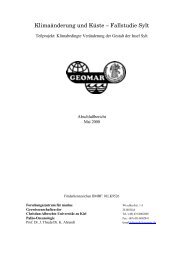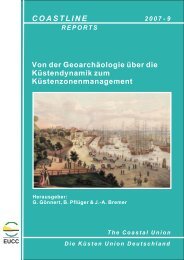COASTLINE - Büro für Umwelt und Küste
COASTLINE - Büro für Umwelt und Küste
COASTLINE - Büro für Umwelt und Küste
Erfolgreiche ePaper selbst erstellen
Machen Sie aus Ihren PDF Publikationen ein blätterbares Flipbook mit unserer einzigartigen Google optimierten e-Paper Software.
Kannen, Schernewski, Krämer, Lange, Janßen & Stybel (eds.):<br />
Forschung für ein Integriertes Küstenzonenmanagement: die Fallbeispiele Odermündungsregion <strong>und</strong><br />
Offshore-Windkraft in der Nordsee<br />
Coastline Reports 15 (2010), ISSN 0928-2734, ISBN 978-3-9811839-7-9<br />
S. 197 - 214<br />
Rechtliche <strong>und</strong> ökonomische Handlungsoptionen sowie<br />
Steuerungsinstrumente am Beispiel der Reduzierung von<br />
<strong>Umwelt</strong>beeinträchtigungen<br />
Jeannette Edler 1 & Jesko Hirschfeld 2<br />
1 Ostseeinstitut für Seerecht, <strong>Umwelt</strong>recht <strong>und</strong> Infrastrukturrecht, Universität Rostock, Deutschland<br />
2 Institut für ökologische Wirtschaftsforschung (IÖW), Berlin<br />
Abstract<br />
Options for action and management or controlling tools<br />
The objective of this article is to examine the legal settings and economic perspective concerning<br />
options for action and controlling tools in Germany. The article deals on the one hand with general<br />
information on options for action and controlling tools and on the other hand with details<br />
concerning controlling tools, especially those which work indirectly.<br />
Firstly, it has to be made clear what is to renew or which goals are to reach. A goal can be defined<br />
in terms of quality or quantity. But sometimes the goal is not a special fact or a number. Then, it<br />
has to be concretized what has to be changed. The weaker, bo<strong>und</strong>lessness and unclear, the target<br />
fails, the more difficult to implement.<br />
Next step is to examine which competencies have to be obtained and which instruments there are in<br />
general.<br />
Different disciplines like law, environmental sciences, economics and techniques have to work<br />
together for best results. For example you have to clarify legally whether the desired objective can<br />
be set in the legally permissible limits and what are the international, european communities or<br />
national specifications. From socio-economic point of view it is f<strong>und</strong>amentally a question of costs<br />
and benefits of measures to improve water quality in the Oder, the Odra Basin and the Baltic Sea<br />
together with the Odra Basin (Oderhaff) balanced. The normative decision about which strains the<br />
budget is reasonable and what the benefit-cost ratio reasonable, it can only be made through a<br />
political process.<br />
Control deficits are divided into their causes, namely lack of controllability, knowledge,<br />
implementation and / or motivation.<br />
Basically, different instruments of environmental law are distinguished: environmental planning,<br />
direct and indirect behavior control. These are different in impact and intensity. While prevalent in<br />
direct instruments of administrative coercion, will be replaced in case of indirect instruments of<br />
coercion freedom, flexibility, market and private autonomy. Examples of indirect controling and<br />
working legal instruments are taxes, allowances, subsidies or selfbinding contracts.<br />
Even if there are management tools, is the different interpretations of concepts or even the different<br />
application, an additional problem dar.<br />
All instruments have their own capacities, advantages and disadvantages. A combination of less<br />
direct working, more selfregulating instruments and a few strict working tools is better than the<br />
older system, because people have choice and more efficient outcomes can be reached. Acceptance<br />
and compliance of rules is rising<br />
Which combination of tax instruments and concrete measures embodiments promises the best<br />
outcome is only after completion of a complex balancing process between the multi-dimensional<br />
effects (ecologically, economically, socially - and even within these categories can in turn be<br />
addressed different dimensions) are chosen measures and their costs .<br />
Indirect control mechanisms are in a position to guide the behavior, particularly in a case related to<br />
the combination.<br />
But they make sense only when essential conditions are met.<br />
In history, there was first a law described like “command and control”. Now, there is a new century<br />
of modern instruments and new concepts of selfregulating and selfbinding tools ending in a new<br />
form of law and order - so called governance-conception.




